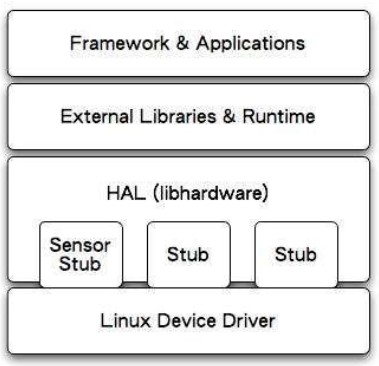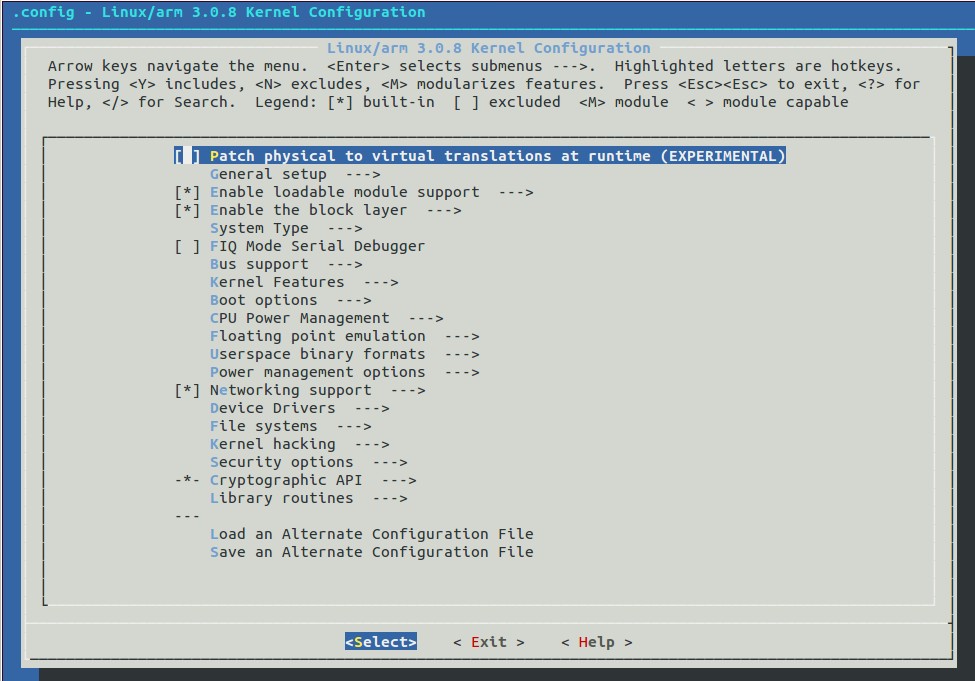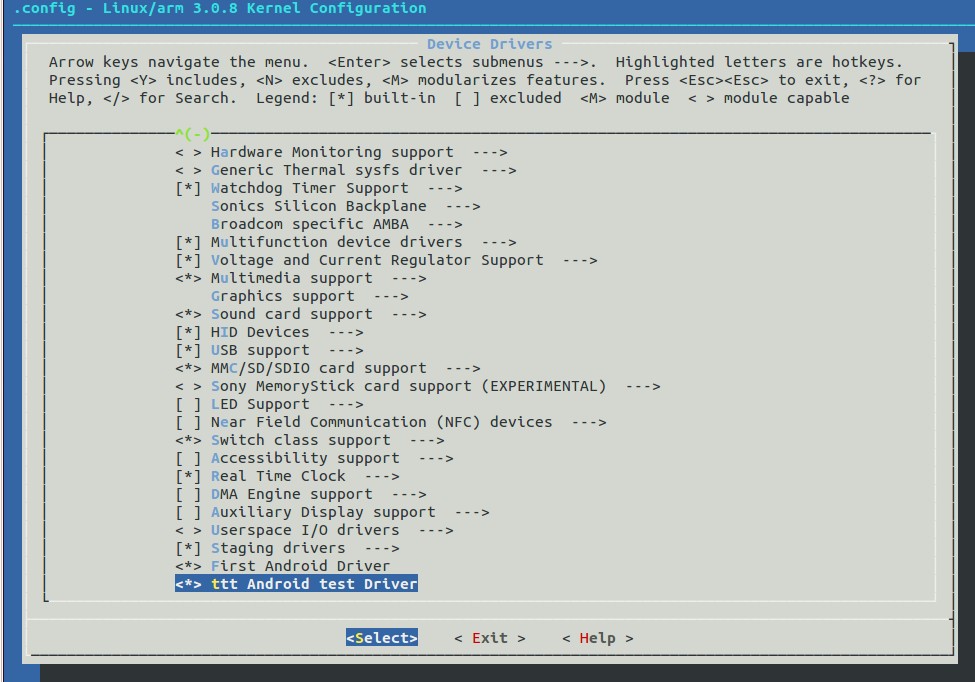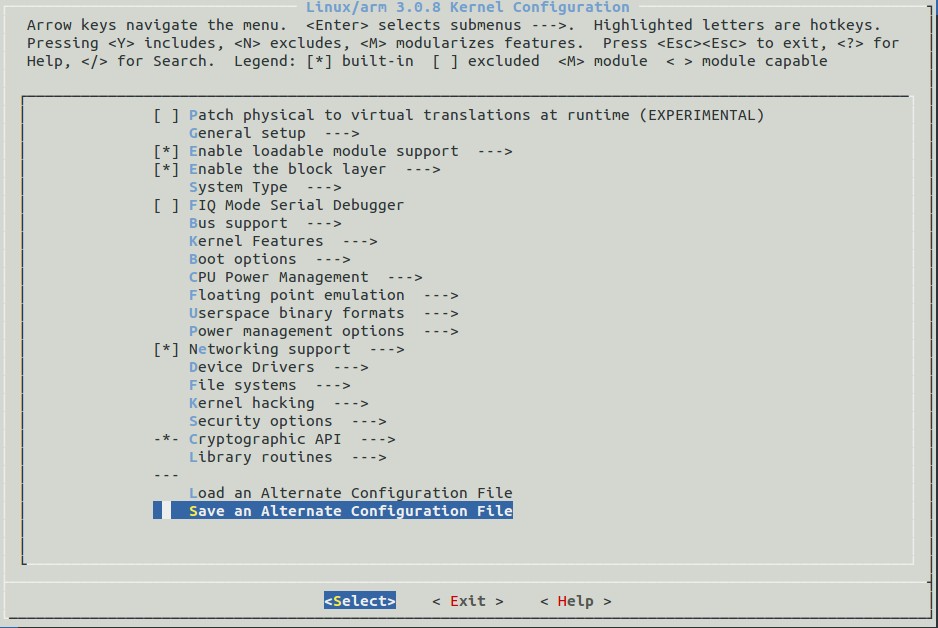Android 驱动开发系列一
最近开始接触Android底层的开发,这里面将记录开发一个驱动以及到测试的全过程。
首先,需要搭建Android的开发环境。我这里采用的是Ubuntu 11.04 64bit的系统,里面使用gcc-4.4,Android 4.0.4源码,硬件是S5PV210。
搭建环境这一步就不说了。
其次,编译好u-boot、kernel和ICS。
最后,开始确定要编写什么驱动。
由于我这个210板子上没有可控制的GPIO设备,所以这里硬件部分就不涉及了,直接编写一个驱动,实现读写接口。
在开始之前,我们先来看看由驱动到接口、应用是怎么一个流程。

从这个图中可以看出我们需要 实现HAL层,实现Framework层,以及编写对应的程序。
在这里,有必要提一下:在Android下有以下两种访问HAL的方式:
1、Android 的 app 直接通过service 调用.so格式的JNI :此方法比较简单高效,但是不正规。
2、经过Manager 调用 Service :此方法实现起来比较复杂,但更符合目前的 Android框架。在此方法中 Manager 进程和 Service(JAVA) 进程需要通过进程通信的方式实现通信。
下面正式开始:
一、HAL层驱动的实现1、添加 ttt 驱动
首先,打开终端,进入到kernel源码目录下的drivers目录,如:
brantyou@brantyou-ubuntu:~/workspace$ cd samsung_android_kernel_3.0/drivers/brantyou@brantyou-ubuntu:~/workspace/samsung_android_kernel_3.0/drivers$ lsaccessibility clk gpio Kconfig misc pcmcia sfi usbacpi clocksource gpu Kconfig~ mmc platform sh uwbamba connector hello leds modules.builtin pnp sn vhostata cpufreq hid lguest modules.order power spi videoatm cpuidle hwmon macintosh mtd pps ssb virtioauxdisplay crypto hwspinlock Makefile net ps3 staging vlynqbase dca i2c Makefile~ nfc ptp switch w1bcma dio ide mca nubus rapidio target watchdogblock dma idle md of regulator tc xenbluetooth edac ieee802154 media oprofile rtc telephony zorrobuilt-in.o eisa infiniband memstick parisc s390 thermalcdrom firewire input message parport sbus ttychar firmware isdn mfd pci scsi uiobrantyou@brantyou-ubuntu:~/workspace/samsung_android_kernel_3.0/drivers$
切换成超级用户权限:
brantyou@brantyou-ubuntu:~/workspace/samsung_android_kernel_3.0/drivers$ sudo -s[sudo] password for brantyou: root@brantyou-ubuntu:~/workspace/samsung_android_kernel_3.0/drivers#
创建 ttt 驱动目录:
root@brantyou-ubuntu:~/workspace/samsung_android_kernel_3.0/drivers# mkdir tttroot@brantyou-ubuntu:~/workspace/samsung_android_kernel_3.0/drivers# lsaccessibility clk gpio Kconfig misc pcmcia sfi uioacpi clocksource gpu Kconfig~ mmc platform sh usbamba connector hello leds modules.builtin pnp sn uwbata cpufreq hid lguest modules.order power spi vhostatm cpuidle hwmon macintosh mtd pps ssb videoauxdisplay crypto hwspinlock Makefile net ps3 staging virtiobase dca i2c Makefile~ nfc ptp switch vlynqbcma dio ide mca nubus rapidio target w1block dma idle md of regulator tc watchdogbluetooth edac ieee802154 media oprofile rtc telephony xenbuilt-in.o eisa infiniband memstick parisc s390 thermal zorrocdrom firewire input message parport sbus tttchar firmware isdn mfd pci scsi ttyroot@brantyou-ubuntu:~/workspace/samsung_android_kernel_3.0/drivers#
进入到ttt目录,并创建 ttt.h 头文件:(这里使用gedit编辑器,大家也可以使用vi或者其他编辑器)
root@brantyou-ubuntu:~/workspace/samsung_android_kernel_3.0/drivers# cd tttroot@brantyou-ubuntu:~/workspace/samsung_android_kernel_3.0/drivers/ttt# gedit ttt.h
然后输入 ttt.h 的内容:
/* * ttt device head file * * Copyright (C) 2013 brantyou Open Source Project * Copyright (C) 2013,2013 brantyou Inc. * * Author: brantyou <brantyou@qq.com> * * Licensed under the Apache License, Version 2.0 (the "License"); * you may not use this file except in compliance with the License. * You may obtain a copy of the License at * * http://www.apache.org/licenses/LICENSE-2.0 * * Unless required by applicable law or agreed to in writing, software * distributed under the License is distributed on an "AS IS" BASIS, * WITHOUT WARRANTIES OR CONDITIONS OF ANY KIND, either express or implied. * See the License for the specific language governing permissions and * limitations under the License. */#ifndef_TTT_ANDROID_H_#define_TTT_ANDROID_H_#include <linux/cdev.h>#include <linux/semaphore.h>#defineTTT_DEVICE_NODE_NAME"ttt"#defineTTT_DEVICE_FILE_NAME"ttt"#defineTTT_DEVICE_PROC_NAME"ttt"#defineTTT_DEVICE_CLASS_NAME"ttt"struct ttt_android_dev{int val;struct semaphore sem;struct cdev dev;};#endif
添加 ttt.c 文件:
root@brantyou-ubuntu:~/workspace/samsung_android_kernel_3.0/drivers/ttt# gedit ttt.c
添加 ttt.c 文件的处理:
/* * ttt device c file * * Copyright (C) 2013 brantyou Open Source Project * Copyright (C) 2013,2013 brantyou Inc. * * Author: brantyou <brantyou@qq.com> * * Licensed under the Apache License, Version 2.0 (the "License"); * you may not use this file except in compliance with the License. * You may obtain a copy of the License at * * http://www.apache.org/licenses/LICENSE-2.0 * * Unless required by applicable law or agreed to in writing, software * distributed under the License is distributed on an "AS IS" BASIS, * WITHOUT WARRANTIES OR CONDITIONS OF ANY KIND, either express or implied. * See the License for the specific language governing permissions and * limitations under the License. */#include <linux/init.h>#include <linux/module.h>#include <linux/types.h>#include <linux/fs.h>#include <linux/proc_fs.h>#include <linux/device.h>#include <asm/uaccess.h>#include "ttt.h"// * Master and slave devices number variablesstatic int ttt_major = 0;static int ttt_minor = 0;// * device types and device variablesstatic struct class* ttt_class = NULL;static struct ttt_android_dev* ttt_dev = NULL;// * traditional method of operation of the device filestatic int ttt_open(struct inode* inode, struct file* flip);static int ttt_release(struct inode* inode, struct file* flip);static ssize_t ttt_read(struct file* flip, char __user* buf, size_t count, loff_t* f_pos);static ssize_t ttt_write(struct file* flip, const char __user* buf, size_t count, loff_t* f_pos);// * the method of operation of the device file tablestatic struct file_operations ttt_fops = {.owner = THIS_MODULE,.open = ttt_open,.release = ttt_release,.read = ttt_read,.write = ttt_write,};// * access to set property methodsstatic ssize_t ttt_val_show(struct device* dev, struct device_attribute* attr, char* buf);static ssize_t ttt_val_store(struct device* dev, struct device_attribute* attr, const char* buf, size_t count);// * define the device propertiesstatic DEVICE_ATTR(val, S_IRUGO | S_IWUSR, ttt_val_show, ttt_val_store);// * open the device methodsstatic int ttt_open(struct inode* inode, struct file* flip){struct ttt_android_dev* dev;printk(KERN_ALERT"[ttt]: ttt_open().\n");// save the device struct to the private areadev = container_of(inode->i_cdev, struct ttt_android_dev, dev);flip->private_data = dev;return 0;}// * releasestatic int ttt_release(struct inode* inode, struct file* filp){printk(KERN_ALERT"[ttt]: ttt_release().\n");return 0;}// * readstatic ssize_t ttt_read(struct file* filp, char __user* buf, size_t count, loff_t* f_pos){ssize_t err = 0;struct ttt_android_dev* dev = filp->private_data;printk(KERN_ALERT"[ttt]: ttt_read().\n");// async accessif(down_interruptible( &(dev->sem) )){return -ERESTARTSYS;}if(count < sizeof(dev->val) ){goto out;}// if(copy_to_user(buf, &(dev->val), sizeof(dev->val) )){err = -EFAULT;goto out;}err = sizeof(dev->val);out:up(&(dev->sem));return err;}// * writestatic ssize_t ttt_write(struct file* filp, const char __user* buf, size_t count, loff_t* f_pos){struct ttt_android_dev* dev = filp->private_data;ssize_t err = 0;printk(KERN_ALERT"[ttt]: ttt_write().\n");// async accessif(down_interruptible( &(dev->sem) )){return -ERESTARTSYS;}if(count != sizeof(dev->val) ){goto out;}// save the buffer value to device registersif( copy_from_user( &(dev->val), buf, count) ){err = -EFAULT;goto out;}err = sizeof(dev->val);out:up(&(dev->sem));return err;}// * read the registers value val to the buffer buf, innerstatic ssize_t __ttt_get_val(struct ttt_android_dev* dev, char* buf){int val = 0;// async accessif(down_interruptible( &(dev->sem) )){return -ERESTARTSYS;}val = dev->val;up( &(dev->sem) );return snprintf(buf, PAGE_SIZE, "%d\n", val);}// * write the buffer value buf to the device registers val, innerstatic ssize_t __ttt_set_val(struct ttt_android_dev* dev, const char* buf, size_t count){int val = 0;// translate the string to numberval = simple_strtol(buf, NULL, 10);// async accessif(down_interruptible( &(dev->sem) )){return -ERESTARTSYS;}dev->val = val;up( &(dev->sem));return count;}// * read the device properties valstatic ssize_t ttt_val_show(struct device* dev, struct device_attribute* attr, char* buf){struct ttt_android_dev* hdev = (struct ttt_android_dev*)dev_get_drvdata(dev);return __ttt_get_val(hdev, buf);}// * write the device properties valstatic ssize_t ttt_val_store(struct device* dev, struct device_attribute* attr, const char* buf, size_t count){struct ttt_android_dev* hdev = (struct ttt_android_dev*)dev_get_drvdata(dev);return __ttt_set_val(hdev, buf, count);}// * read the device registers val, and save to the page bufferstatic ssize_t ttt_proc_read(char* page, char** start, off_t off, int count, int* eof, void* data){if(off > 0){*eof = 1;return 0;}return __ttt_get_val(ttt_dev, page);}// * save the buffer value buff to the device registers valstatic ssize_t ttt_proc_write(struct file* filp, const char __user* buff, unsigned long len, void* data){int err = 0;char* page = NULL;if(len > PAGE_SIZE){printk(KERN_ALERT"[ttt]: The buff is too large:%lu.\n", len);return -EFAULT;}page = (char*)__get_free_page(GFP_KERNEL);if(!page){printk(KERN_ALERT"[ttt]: Failed to alloc page.\n");return -ENOMEM;}// copy the user buffer value to kernel bufferif(copy_from_user(page, buff, len) ){printk(KERN_ALERT"[ttt]: Failed to copy buff from user.\n");err = -EFAULT;goto out;}err = __ttt_set_val(ttt_dev, page, len);out:free_page( (unsigned long)page);return err;}// * create /proc/ttt filestatic void ttt_create_proc(void){struct proc_dir_entry* entry;entry = create_proc_entry(TTT_DEVICE_PROC_NAME, 0, NULL);if(entry){entry->owner = THIS_MODULE;entry->read_proc = ttt_proc_read;entry->write_proc = ttt_proc_write;}}// * delete /proc/ttt filestatic void ttt_remove_proc(void){remove_proc_entry(TTT_DEVICE_PROC_NAME, NULL);}// * init devicestatic int __ttt_setup_dev(struct ttt_android_dev* dev){int err;dev_t devno = MKDEV(ttt_major, ttt_minor);memset(dev, 0, sizeof(struct ttt_android_dev) );cdev_init( &(dev->dev), &ttt_fops);dev->dev.owner = THIS_MODULE;dev->dev.ops = &ttt_fops;// registe charater deviceerr = cdev_add( &(dev->dev), devno, 1);if(err){return err;}// init single and registers value valinit_MUTEX(&(dev->sem));dev->val = 0;return 0;}// * load modulestatic int __init ttt_init(void){int err = -1;dev_t dev = 0;struct device* temp = NULL;printk(KERN_ALERT"[ttt]: Initializing ttt device.\n");// malloc master and slave device numbererr = alloc_chrdev_region( &dev, 0, 1, TTT_DEVICE_NODE_NAME);if(err < 0){printk(KERN_ALERT"[ttt]: Failed to alloc char dev region.\n");goto fail;}ttt_major = MAJOR(dev);ttt_minor = MINOR(dev);// alloc ttt device struct valiriablettt_dev = kmalloc( sizeof(struct ttt_android_dev), GFP_KERNEL);if(!ttt_dev){err = -ENOMEM;printk(KERN_ALERT"[ttt]: Failed to alloc ttt_dev.\n");goto unregister;}// init deviceerr = __ttt_setup_dev(ttt_dev);if(err){printk(KERN_ALERT"[ttt]: Failed to setup dev:%d.\n", err);goto cleanup;}// create device type directory ttt on /sys/class/ttt_class = class_create(THIS_MODULE, TTT_DEVICE_CLASS_NAME);if(IS_ERR(ttt_class)){err = PTR_ERR(ttt_class);printk(KERN_ALERT"[ttt]: Failed to create ttt class.\n");goto destroy_cdev;}// create device file ttt on /dev/ and /sys/class/ttttemp = device_create(ttt_class, NULL, dev, "%s", TTT_DEVICE_FILE_NAME);if(IS_ERR(temp)){err = PTR_ERR(temp);printk(KERN_ALERT"Failed to create ttt device.\n");goto destroy_class;}// create property file val on /sys/class/ttt/ttterr = device_create_file(temp, &dev_attr_val);if(err < 0){printk(KERN_ALERT"[ttt]: Failed to create attribute val.\n");goto destroy_device;}dev_set_drvdata(temp, ttt_dev);// create /proc/ttt filettt_create_proc();printk(KERN_ALERT"[ttt]: Successed to initialize ttt device.\n");return 0;destroy_device:device_destroy(ttt_class, dev);destroy_class:class_destroy(ttt_class);destroy_cdev:cdev_del(&ttt_dev->dev);cleanup:kfree(ttt_dev);unregister:unregister_chrdev_region(MKDEV(ttt_major, ttt_minor), 1);fail:return err;}// * unload modulestatic void __exit ttt_exit(void){dev_t devno = MKDEV(ttt_major, ttt_minor);printk(KERN_ALERT"[ttt]: Destroy ttt device.\n");// delete /proc/ttt filettt_remove_proc();// destroy device type and deviceif(ttt_class){device_destroy(ttt_class, MKDEV(ttt_major, ttt_minor) );class_destroy(ttt_class);}// delete character device and release device memoryif(ttt_dev){cdev_del(&(ttt_dev->dev) );kfree(ttt_dev);}// destroy device numberunregister_chrdev_region(devno, 1);}MODULE_LICENSE("GPL");MODULE_DESCRIPTION("Android Test Device");module_init(ttt_init);module_exit(ttt_exit);接下来则添加 Kconfig 配置文件:(make menuconfig时会用到)
config TTTtristate "ttt Android test Driver"default nhelpIt is a Android test driver.
添加 ttt 的 Makefile 文件:
obj-$(CONFIG_TTT) += ttt.o
修改 drivers/Kconfig 文件,在menu "Device Drivers"和endmenu之间添加驱动模块配置选项:
source "drivers/ttt/Kconfig"
在 drivers/Makefile 文件末尾添加:
obj-$(CONFIG_TTT)+= ttt/
这样是为了方便定制内核,在make menuconfig的时候可以找到我们新加入的模块。
好了,驱动到此基本编写完了,下面开始选中新家的驱动编译一下内核:
回到内核源码目录下执行 make menuconfig:
root@brantyou-ubuntu:~/workspace/samsung_android_kernel_3.0# lsarch Documentation ipc Makefile README System.mapblock drivers Kbuild mm REPORTING-BUGS toolscesv210_android_defconfig firmware Kconfig modules.builtin samples usrCOPYING fs kernel modules.order scripts virtCREDITS include lib Module.symvers security vmlinuxcrypto init MAINTAINERS net sound vmlinux.oroot@brantyou-ubuntu:~/workspace/samsung_android_kernel_3.0# make menuconfig
将会出现这样一个定制内核模块的界面:
按上下键选择 Device Drivers 按 enter进入下面的界面:

最后面这个驱动模块就是我们刚才加进去的,按 y 键选择,然后选中Exit,按enter键回到下面的界面:

选中最好一个Save an Alternate Configuration File按enter,保存后,退出这个配置。
然后执行make编译命令:
root@brantyou-ubuntu:~/workspace/samsung_android_kernel_3.0# make
编译成功后,驱动会包含在zImage里面。
然后在arch/arm/boot/目录下看到生成的zImage Kernel文件,把这个文件烧写到板子。
root@android:/ # ll /dev/tttcrw------- root root 249, 0 2013-03-21 13:59 ttt
这样就说明ttt驱动已经成功加到内核了。
驱动编写完了,这章就先到这里了